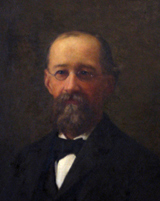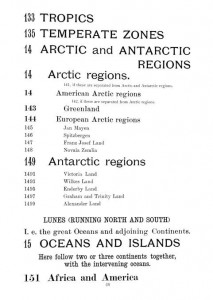
The Cutter Expansive Classification system is a library classification system devised by Charles Ammi Cutter, who was Librarian at the Forbes Library from 1894-1903. Like other classification systems it assigns a number to subject areas so that when books are numbered according to subject and then arranged by those numbers, books on similar topics are shelved together. It lost popularity gradually to the Dewey Decimal system in public libraries; in academic libraries it has been replaced by the Library of Congress system, which was developed partly from Mr. Cutter’s ideas.
Contents
The Expansive Classification
The Cutter Expansive Classification system exists as a series of increasingly subdivided versions. The first is very simple and is intended for use at the smallest libraries. The seventh is the most complex and is intended for the largest libraries. Forbes Library uses Cutter’s Seventh Classification. In the Children’s Department, the Sixth Classification is used, except for History which follows the Seventh. For examples of how these classifications are used in the existing collection, you can look up any subject in the library’s online catalog.
Subject areas (by initial letter of each class)
A list of the subjects found under each initial letter provides a rough overview of the classification:
- A
- General Works: encyclopedias, almanacs, index, and quotations
- B
- Philosophy, psychology, and some religion
- C
- Christian and Jewish religions
- D
- Church History: the history of Christian faith and denominations
- E
- Biography
- F
- History
- G
- Geography and travel
- H
- Social Sciences: statistics, economics, business, investment, consumer information
- I
- Sociology, Education, and Careers
- J
- Political Science
- K
- Law and Families
- L
- General Sciences: mathematics, computer science, the Internet and the World Wide Web, physics and chemistry
- M
- Natural Sciences: environmental science, ecology, weather, geology, oceanography, biology
- N
- Botany
- O-P
- Zoology and Animal Behavior
- Q
- Medicine: health, homeopathy, naturopathy, medical directories, mental health.
- R
- Technology/Useful Arts: invention and patents, agriculture, horticulture, forestry, home economics, nutrition and food, cooking, dieting
- S
- Engineering and Building: construction, engineering, transportation, cars, railroads
- T
- Handicrafts and Manufacturing: carpentry, sewing, machines, metalwork, leather, textiles, plastics
- U
- War and the Military
- V
- Athletics, Recreation, Music, Performing Arts
- W
- Art: art history, architecture, sculpture, drawing, painting, photography, needlework, furniture
- X
- Language
- Y
- Literature: fiction, drama, poetry, essays, speeches
- Z
- Books and Literary History: writing, printing, public libraries, bibliography, literary criticism, author information
The Order of Expansive Classification Numbers
Although Mr. Cutter proposed several different methods of ordering Expansive Classification numbers, most of these were in response to complaints that the system was too complicated; there is really only one way of ordering the numbers that makes sense, so that similar subjects appear together. This is the order Cutter used in his own tables.
The numbers are compared one character at a time, from left to right, just as you would order titles alphabetically. This is simple so long as one is comparing digits to digits or letters to letters, but more involved when digits, letters, or punctuation marks must be compared to each other.
In our section on finding materials in the library you can find the rules for ordering call number enumerated, with examples.
The Structure of Expansive Classification Numbers
The first part of the call number is the class mark. It generally corresponds to the subject of the item though it may also correspond to literary form (drama, poetry, biography, etc.) The class mark consists of everything up to the first period (.), plus (+), or parallel (∥ or //). Class marks at Forbes Library always start with a letter.
The second part of the call number is known as the book mark or author mark. It serves only to order books within the class and does not indicate anything about the subject of the book. The book mark consists of everything after the first period (.), plus (+), or parallel (∥ or //). The book is frequently the Cutter number for the author’s name (see below) plus one or more letters for the title of the book.
The book mark may start with a number, most often a single digit. These group books of a particular form within a class, as follows:
- 05
- Gazetteers for a country or region (used only in subclasses of of the class G)
- 06
- Guidebooks for a country or region (used only in subclasses of of the class G)
- 1
- Theory of the subject
- 2
- Bibliography of the subject
- 3
- Biography of the subject, with biographies of many individuals
- 31
- Biography of the subject, treating the life of a single individual
- 4
- History of the subject
- 5
- Dictionaries and encyclopedias of the subject
- 6
- Handbooks, etc., of the subject
- 7
- Periodicals limited to the subject
- 8
- Societies devoted to the subject
- 9
- Collections of works on subject by several authors
Cutter Numbers
Charles Ammi Cutter devised an “Alfabetic Order Table” to help catalogers map potentially long words and phrases to short alphanumeric strings so that sorting by the strings also correctly sorts the original words. These strings are now known as Cutter Numbers and the process is known as cuttering. The Cutter Numbers used at Forbes Library consist between one and three of the initial letters of the word or phrase followed by two
or more digits. For example Schubert, Franz might be mapped to Sch78 and Lincoln, Abraham might be mapped to L638. Cutter Numbers frequently appear in the book mark but may be part of a class mark as well.
 Geographic Subdivisions
Geographic Subdivisions
Numbers in a class mark often represent a geographic. For example, W66 is the class for Chinese art and W40 is the class for Spanish art. Similarly W83 is the class for American art. These numbers are consistent across classes; 66 indicates China, 40 indicates Spain, and 83 indicates North America wherever geographic subdivisions are used, so the F40 is the history of Spain and F66 is the history of China. Note, however, that numbers may also appear in a class mark if it includes a Cutter Number; for example, though G34 is the class for the geography of Greece, the 34 in the class mark EY34 does not represent Greece, but is part of the Cutter Number Y34. (EY34 is the class mark for biographies of William Butler Yeats.)
Recommended reading
Expansive Classification: Part I: The First Six Classifications. EBook hosted by Archive.org (The formatting is crucial, so be sure to use the “read online” option or download the PDF.)
Includes schedules of the first six classifications, as well as extensive notes on the systems purpose and use. Note that schedules of the seventh classification are incomplete and are not available online at this time.
Miska, Francis L (ed.). Charles Ammi Cutter, Library Systematizer. Libraries Unlimited. 1977. (Forbes Catalog | WorldCat)
A collection of writings by Charles Ammi Cutter, including excerpts from his personal correspondence which which have not been published elsewhere. Also includes a biography and essays on Cutter’s contributions to library science.
Miksa, Francis L. Charles Ammi Cutter: Nineteenth-Century Systematizer of Libraries. University of Chicago, June 1974. (Dissertation).
